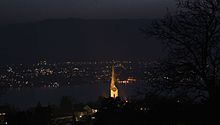Reformed Church Zollikon
The reformed church Zollikon is in the center of the village Zollikon on the lower right Lake Zurich . It was created between 1497 and 1499.
history
A chapel and later a small church stood on the site of today's church as early as the 9th century. The reformed church in Zollikon was first mentioned in 1223, when the abbots of Kappel am Albis and Muri settled a tithing dispute in ecclesiam Zollicon . The Romanesque church consisted of a rectangular nave and a square tower choir.
In 1495 the Zolliker received the right from the City Council of Zurich to collect money for the construction of a new church. In 1497/98 the nave and the bell tower with its Käsbissen roof were built. A year later, after the settlement of a dispute with the Grossmünster monastery about funding, the choir was also rebuilt. The middle of the three coats of arms was also from the same year . It shows the German imperial eagle and was created by Lux (Lukas) Zeiner. The two Zurich stand signs next to it date from 1520 and were created by Lienhart Brun. In 1743 the heavy wooden ceiling was replaced by a plaster ceiling with stucco by Johannes Meyer. In 1795 the Käsbissenturm, which was damaged by lightning in 1691 and partially collapsed in 1794, was replaced by a pointed helmet. The tall and slim helmet of the Fraumünster in Zurich served as a model . Johannes Volkart (1759–1804) from Enge and the Zolliker Johann Murer were in charge of construction. The tower received four dials, each with an eyelash and a pointed helmet covered with wooden shingles, which was re-covered with copper shingles in 1898. In addition, four new bells were inaugurated. They are tuned to B flat major and come from the H. Rüetschi bell foundry in Aarau. The tower height is 52.63 meters to the top of the helmet and 65.83 meters to the top of the pole. The sphere diameter is 50 centimeters.
In 1836 the Grossmünster ceded the choir to the state, which passed it on to Zollikon in 1888. In 1908 electric lights were installed and a parish room was added next to the choir. The pulpit, panels and benches were rebuilt, and a first organ was installed in the choir. The master builder Hermann Fietz (1869–1931) was in charge of this work. Since the church with its 400 seats repeatedly proved to be too small, the nave on the north side was extended in 1937 by an extension with 170 additional seats. A new organ was installed in a gallery in 1971 by Orgelbau Kuhn , Männedorf ; the old organ from 1908, also built by Kuhn, came to Rohrbach in the canton of Bern.
In 1967 the church underwent a total renovation and received its current appearance. Among other things, the heavy-looking paneling was removed, the benches were replaced, and the font that was removed in 1908 was reinstalled. Church, tower and interior were painted white. The architect was Werner Blumer from Zollikon.
In 1971 the third organ in the history of the Zollikon Church was inaugurated. Since 1984 the new parish hall has been completing the church center of Zollikon.
baptist
During the Reformation, Zollikon was the starting point for the Anabaptist movement . On the evening of January 21, 1525, the baptism of believers was donated for the first time in a private house in Zurich . Fear of persecution by the City Council of Zurich, which had previously ordered the forced baptism of infants in the dispute with the Anabaptists, the baptized fled to Zollikon. As a result of Jörg Blaurock's sermon, a great revival movement arose within a few days, which reached people of all walks of life. Many wanted baptism. They gathered according to the early Christian pattern in the village church, but also at fountains on the Nebelbach and in private houses. The fathers of the house read the New Testament texts from the Lord's Supper and offered bread and wine to those present. These gatherings can be seen as the first Protestant communion celebrations in the Zurich area, as evangelical preaching in the churches of Zurich until Easter 1525, but the communion was celebrated according to the Roman Catholic rite.
A plaque at Gstadstrasse 25 today commemorates one of the first Anabaptist meetings in Zollikon. Today, supporters of the Anabaptist community from all over the world come to Gstadstrasse and the village church.
literature
- U. Bräm: Zollikon - a local customer. 1990.
- H. Bruppacher: The old Zollikon. 1899.
- H. Glarner: Zolliker years. 1987.
- P. Guyer: 1000 years of Zollikon. Schulthess-Verlag, Zurich 1946.
- A. Heer: Our Zollikon. Zollikon 1968.
- H. Hess, R. Humm, E. Walder: Welcome to Zollikon.
- Wilfried Maurer: The Zolliker village church. Reformed parish of Zollikon, 2004.
Web links
Individual evidence
- ↑ Zolliker year Issue 1984
- ^ Wilfried Maurer: The Zolliker Village Church, Reformed Church Community Zollikon, 2004
- ^ Fritz Blanke: Brothers in Christ. The history of the oldest Anabaptist community , Zurich 1955
Coordinates: 47 ° 20 '17.6 " N , 8 ° 34' 27.4" E ; CH1903: 685827 / 243660











